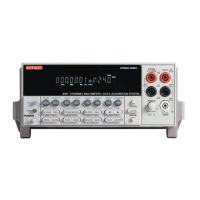Model 2701 User’s Manual Basic DMM Operation 3-25
Performing offset-compensated ohms measurements
Offset-compensated ohms can only be performed on the Ω4 function using the 100Ω, 1kΩ,
or 10kΩ range. Make sure you use 4-wire connections to the DUT (see “Connections,”
page 3-8).
NOTE Make sure the INPUTS switch is in the correct position. To use front panel
inputs, it must be in the “F” (out) position. For switching modules, it must be in
the “R” (in) position.
1. If a switching channel is presently closed (displayed), press OPEN to open it.
2. Select the 4-wire ohms measurement function by pressing Ω4. Enable offset
compensated ohms by pressing SHIFT and then OCOMP (OCOMP annunciator
turns on).
3. Use the RANGE
and keys to select the 100Ω, 1kΩ, or 10kΩ range or press
AUTO to enable auto range. If using auto range, offset compensated ohms
measurements will not be performed if the instrument goes to the 100kΩ or higher
range.
4. Perform steps 4 through 8 of the “Standard resistance measurements,” page 3-23,
procedure.
NOTE The OCOMP annunciator will flash when the instrument is on an invalid range
(100k
Ω
through 100M
Ω
ranges) for offset-compensated ohms. Normal ohms
measurements will instead be performed.
For buffer recall, there is no way to distinguish between a normal ohms reading
and an offset-compensated ohms reading. The OCOMP annunciator (off, on, or
flashing) has no significance for recalled resistance readings that are displayed.
Buffer operation is covered in Section 6.
With offset-compensated ohms enabled, it will be “remembered” by the
Ω
4
function after you change measurement functions (i.e., DCV). When
Ω
4 is again
selected, offset-compensated ohms will be enabled.
Measurement methods
The Model 2701 uses two methods to measure resistance:
• Constant-current source method (100Ω through 1MΩ ranges) – Sources a
constant-current to the DUT. Voltage is measured by the Model 2701and resistance
is then calculated (R = V/I).
• Ratiometric method (10MΩ and 100MΩ ranges) – Test current is generated by a
0.7µA source in parallel with a 10MΩ reference resistor.

